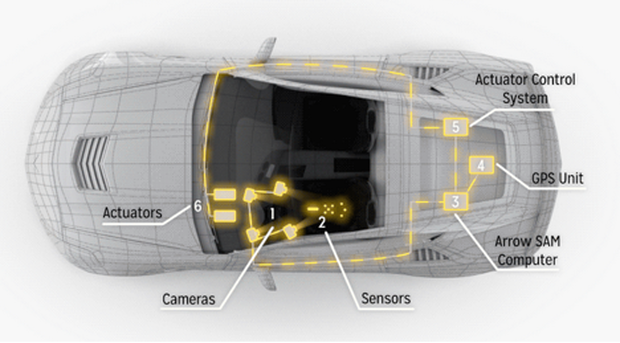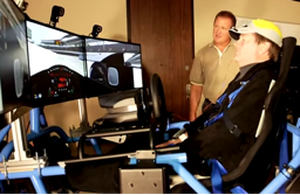Paralyzed driver exceeds 100 mph at Indy thanks to IoT technology

Image: Schmidt Petersen Racing
I was invited to attend IoT Immersions a convention sponsored by Arrow Electronics, a company that focuses on machine to machine intelligence. I agreed with reservation, knowing it most likely would be yet another gathering with vendors selling their wares, and sessions where the same vendors would discuss the benefits of using their products.
I was very wrong. At IoT Immersions, I met a gentleman in a wheelchair, who was unable to shake my hand, yet he drove a late-model Corvette around the Indianapolis Motor Speedway at speeds in excess of 100 mph during the first day of qualifying for the 2014 Memorial Day race. The gentleman did not qualify, but after talking to him, I'm betting that's next on his list.
What, you may ask, does this have to do with the Internet of Things? It has everything to do with IoT. Definitions for IoT abound; yet, no matter how divergent the definitions are, most if not all discuss getting disparate "things" to communicate and function together with the intent of making human life better. And management at Arrow Electronics, rather than just say the company has expertise in the IoT realm, decided to show they do, and in dramatic fashion.
Eleven months and counting
The Indianapolis 500 is time-honored tradition in the US that takes place during Memorial Day weekend every May. Mike Long, CEO of Arrow Electronics and self-admitted car racing enthusiast, set a goal for the company in June 2013. Arrow Electronics would have an experimental car ready for the 2014 Indy 500.
Playing off of Long's lead, Joe Verrengia, director of corporate social responsibility, and others at Arrow, came up with an idea: Why not modify a Corvette so it could be driven by a person with quadriplegia. That would definitely require a "working human-machine interface."
Verrengia and Arrow engineers got together with the Craig Rehabilitation Hospital and Ball Aerospace to brainstorm and before long SAM (Semi-Autonomous Motorcar) was born. The idea even grew more audacious: 80% of the parts had to be off the shelf and the car had to be stable at high speeds.
At IoT Innovations, Verrengia mentioned his first task was to find someone to drive the car. Before long, Verrengia came across Sam Schmidt; a successful Indy-car owner and former driver, who because of a crash during off-season testing is now a quadriplegic. With some trepidation, Verrengia called Schmidt and explained what Arrow was trying to do. Schmidt said he would think about it. Verrengia, smiling, added, "Less than a second later Sam called back and said, 'You build it, I'll drive it.'" Schmidt, after hanging up sent a text to Verrengia, "Make sure the car can go faster than 100 mph."
With the idea and driver lined up, Arrow engineers, many of whom are gear heads themselves, got to work designing the platform. On December 13, five months before Indy, the team took ownership of a stock 2014 Corvette C7 Stingray.
IoT components
Earlier, mention was made that a requirement of the IoT is getting disparate components to communicate. SAM certainly is an example of that. Sensors, infrared cameras, actuators, and GPS transceivers all had to work together so Schmidt could drive the Corvette.
Steering was the big hurdle, and why Ball Aerospace was part of the team. Timothy Choate, senior business manager of aerospace and cyberspace at Ball, mentioned, "What we are looking at is not to take the human out of the loop, it is to use the machine to augment the human capability and improve human performance."
Engineers at Ball Aerospace started by identifying Schmidt's capabilities and matching them to what's required to drive the car. "Despite his injuries, Mr. Schmidt has the ability to move his head, which has allowed the Ball team to convert the driver's head movements into computer code to steer, speed up and slow down the car," mentions the Ball website. "An infrared camera mounted in the car, and sensors placed on headgear worn by Sam tracked the angle and movements of his head; a bite-sensor device brakes the car when he bites down."
Even sneezing is safe
"The engineers programmed the computer to ignore a list of certain head movements including sneezing," responded Verrengia. Safety equipment consisted of military-grade GPS (five-inch accuracy). The course around the track was plotted, and if car deviated outside parameters, the system would shut the car down. Schmidt also had a co-pilot, Arrow engineer Andrew Dawes, who could take over if required.

Image: Arrow Electronics
Arrow Electronics, as the integrator of the SAM project had eight engineers working full-time getting all of the components and safety equipment to talk to the Arrow SAM computer.
Late February, the team went to Dayton Ohio where Ball Aerospace had a simulator set up. The nearby Air

Image: Ball Aerospace
Force Research Lab built a sensor harness for Schmidt to keep track of his vitals. Schmidt, ever the race-car driver maintained a heart rate of 59 during the actual Indy drive.
After successfully running his four qualifying laps, Schmidt, who has been involved in motor racing since his fifth birthday, told the Arrow engineers it was the first time since his accident he's felt normal.
Schmidt qualified at 97 mph. The engineers, remembering Schmidt's stipulation, tweaked the computer. The day after the Indy 500, it was official, Schmidt and Dawes ran laps at 107 mph as seen in this YouTube video.
What IoT means to the SAM team
I asked people on the SAM Project what the IoT meant to them. Several mentioned their hope is the IoT will allow all people to be "drivers of their lives." Verrengia told me the most amazing thing to him was that Arrow did not invent anything: just repurposing hardware gave Schmidt a better life and a new outlook that he could accomplish more than he already has.
Verrengia, as he was leaving, added, "Almost forgot to mention, we sent Google a challenge to race their autonomous car." That would be history in the making: an Internet of Things car race.


